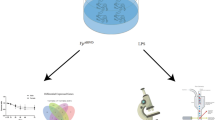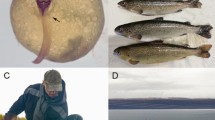Abstract
The red drum Sciaenops ocellatus is a marine fish species of high commercial interest. Despite improvements in current aquaculture practices, there are still concerns about the impact of daily manipulations regarding fish welfare. To investigate how does fish respond to various challenges, S. ocellatus juveniles were submitted to two acute challenges, namely a confinement stress and a cold-temperature shock, as well as a chronic stress challenge consisting of 18 days of repetitive challenge events. The level of cortisol produced by individuals was used as a measure of activation hypothalamic-pituitary-interrenal (HPI) axis. A significant increase in cortisol levels was detected only after the confinement stress. Interestingly, the fish exposed to a chronic stress for 18 days exhibited cortisol levels significantly lower than those of non-challenged fish. The small RNA-sequencing conducted for the chronic stress experiment only allowed us to identify two plasmatic microRNAs more abundant in non-challenged fish (miR-205–1-5p and let-7b-5p) compared to challenged fish. The miR-205–1-5p was of particular interest since it was already detected in previous studies on other fish species. In silico analysis allowed to predict potentially highly conserved mRNA targets of this specific miRNA, among which is tnfrsfa that plays a key role in the secondary stress response.



Similar content being viewed by others

Data availability
All data generated or analyzed during this study are included in this article and supplementary information.
References
Agarwal V, Bell GW, Nam J-W, Bartel DP (2015) Predicting effective microRNA target sites in mammalian mRNAs. Elife 4:e05005. https://doi.org/10.7554/eLife.05005
Alfonso S, Gesto M, Sadoul B (2021) Temperature increase and its effects on fish stress physiology in the context of global warming. J Fish Biol 98(6):1496–1508. https://doi.org/10.1111/jfb.14599
Bartel DP (2009) microRNAs: target recognition and regulatory functions. Cell 136(2):215–233. https://doi.org/10.1016/j.cell.2009.01.002
Bartel DP (2018) Metazoan microRNAs. Cell 173(1):20–51. https://doi.org/10.1016/j.cell.2018.03.006
Barton BA (2002) Stress in fishes: a diversity of responses with particular reference to changes in circulating corticosteroids1. Integr Comp Biol 42(3):517–525. https://doi.org/10.1093/icb/42.3.517
Burgos-Aceves MA, Cohen A, Smith Y, Faggio C (2018) microRNAs and their role on fish oxidative stress during xenobiotic environmental exposures. Ecotoxicol Environ Saf 148:995–1000. https://doi.org/10.1016/j.ecoenv.2017.12.001
Bushnell B (2014) BBMap: a fast, accurate, splice-aware aligner (LBNL-7065E). Lawrence Berkeley National Lab. (LBNL), Berkeley, CA (United States). https://www.osti.gov/biblio/1241166
Cadonic IG, Ikert H, Craig PM (2020) Acute air exposure modulates the microRNA abundance in stress responsive tissues and circulating extracellular vesicles in rainbow trout (Oncorhynchus mykiss). Comp Biochem Physiol D: Genomics Proteomics 34:100661. https://doi.org/10.1016/j.cbd.2020.100661
Campos C, Sundaram AY, Valente LM, Conceição LE, Engrola S, Fernandes JM (2014) Thermal plasticity of the miRNA transcriptome during Senegalese sole development. BMC Genomics 15(1):525. https://doi.org/10.1186/1471-2164-15-525
Desvignes T, Batzel P, Sydes J, Eames BF, Postlethwait JH (2019) miRNA analysis with Prost! reveals evolutionary conservation of organ-enriched expression and post-transcriptional modifications in three-spined stickleback and zebrafish. Sci Rep 9(1):3913. https://doi.org/10.1038/s41598-019-40361-8
Falguière J-C (2011) L’ombrine ocellée (sciaenops ocellatus): Biologie, pêche, aquaculture et marché (Éditions Quae). Éditions Quae. https://www.torrossa.com/en/resources/an/5064059
Fanouraki E, Mylonas CC, Papandroulakis N, Pavlidis M (2011) Species specificity in the magnitude and duration of the acute stress response in Mediterranean marine fish in culture. Gen Comp Endocrinol 173(2):313–322. https://doi.org/10.1016/j.ygcen.2011.06.004
FAO (2022) The state of world fisheries and aquaculture 2022 (FAO Information Division). FAO. https://doi.org/10.4060/cc0461en
Foss A, Grimsbø E, Vikingstad E, Nortvedt R, Slinde E, Roth B (2012) Live chilling of Atlantic salmon: physiological response to handling and temperature decrease on welfare. Fish Physiol Biochem 38(2):565–571. https://doi.org/10.1007/s10695-011-9536-6
Gatlin DMIII (2002) Red drum, Sciaenops ocellatus. In: Webster CD, Lim C (eds) Nutrient requirements and feeding of finfish for aquaculture. CABI Publishing, UK, pp 147–158. https://doi.org/10.1079/9780851995199.0147
Gentleman RC, Carey VJ, Bates DM, Bolstad B, Dettling M, Dudoit S, Ellis B, Gautier L, Ge Y, Gentry J, Hornik K, Hothorn T, Huber W, Iacus S, Irizarry R, Leisch F, Li C, Maechler M, Rossini AJ, …, Zhang J (2004) Bioconductor: open software development for computational biology and bioinformatics. Genome Biol 5(10):R80. https://doi.org/10.1186/gb-2004-5-10-r80
Gjerstad JK, Lightman SL, Spiga F (2018) Role of glucocorticoid negative feedback in the regulation of HPA axis pulsatility. Stress (Amsterdam, Netherlands) 21(5):403–416. https://doi.org/10.1080/10253890.2018.1470238
Goikoetxea A, Sadoul B, Blondeau-Bidet E, Aerts J, Blanc M-O, Parrinello H, Barrachina C, Pratlong M, Geffroy B (2021) Genetic pathways underpinning hormonal stress responses in fish exposed to short- and long-term warm ocean temperatures. Ecol Ind 120:106937. https://doi.org/10.1016/j.ecolind.2020.106937
Houdelet C, Blondeau-Bidet E, Estevez-Villar M, Mialhe X, Hermet S, Ruelle F, Dutto G, Bajek A, Bobe J, Geffroy B (2023) Circulating microRNAs indicative of sex and stress in the European seabass (Dicentrarchus labrax): toward the identification of new biomarkers. Mar Biotechnol. https://doi.org/10.1007/s10126-023-10237-0
Hsieh HJ, Hsien Y-L, Jeng M-S, Tsai W-S, Su W-C, Chen CA (2008) Tropical fishes killed by the cold. Coral Reefs 27(3):599–599. https://doi.org/10.1007/s00338-008-0378-3
Hsu T-H, Gwo J-C (2017) Fine-scale genetic structure of rabbitfish, Siganus fuscescens, in Penghu Archipelago following a mass mortality event caused by extreme cold winter weather. Genes Genom 39(6):645–652. https://doi.org/10.1007/s13258-017-0530-y
Hurst TP (2007) Causes and consequences of winter mortality in fishes. J Fish Biol 71(2):315–345. https://doi.org/10.1111/j.1095-8649.2007.01596.x
Ikert H, Lynch MDJ, Doxey AC, Giesy JP, Servos MR, Katzenback BA, Craig PM (2021) High throughput sequencing of microRNA in rainbow trout plasma, mucus, and surrounding water following acute stress. Front Physiol 11:588313. https://doi.org/10.3389/fphys.2020.588313
Khursigara AJ, Johansen JL, Esbaugh AJ (2021) The effects of acute crude oil exposure on growth and competition in red drum, Sciaenops ocellatus. Sci Total Environ 751:141804. https://doi.org/10.1016/j.scitotenv.2020.141804
Laberge F, Yin-Liao I, Bernier NJ (2019) Temporal profiles of cortisol accumulation and clearance support scale cortisol content as an indicator of chronic stress in fish. Conserv Physiol 7(1):coz052. https://doi.org/10.1093/conphys/coz052
Lai KP, Li J-W, Tse AC-K, Chan T-F, Wu RS-S (2016) Hypoxia alters steroidogenesis in female marine medaka through miRNAs regulation. Aquat Toxicol 172:1–8. https://doi.org/10.1016/j.aquatox.2015.12.012
Li Y, Xiao T, Zou J (2021) Fish TNF and TNF receptors. Sci China Life Sci 64(2):196–220. https://doi.org/10.1007/s11427-020-1712-4
Liu H, Yu H, Yu Y, Bao X, Zhou J, Zeng W, Peng Z, Yang Y, Duan N (2022) miRNA and mRNA expression analysis reveals the effects of continuous heat stress on antibacterial responses to Aeromonas hydrophila lipopolysaccharide (LPS) in grass carp (Ctenopharyngodon idella). Fish Shellfish Immunol 130:332–341. https://doi.org/10.1016/j.fsi.2022.09.014
Love MI, Huber W, Anders S (2014) Moderated estimation of fold change and dispersion for RNA-seq data with DESeq2. Genome Biol 15(12):550. https://doi.org/10.1186/s13059-014-0550-8
Matlock GC (1987) The life history of red drum. In: Chamberlain GW, Miget RJ, Haby MG (eds) Manual of red drum aquaculture. Texas agricultural extension service and sea grant college program. Texas A&M University, Texas, pp 1–47
Michie LE, Hitchcock JN, Thiem JD, Boys CA, Mitrovic SM (2020) The effect of varied dam release mechanisms and storage volume on downstream river thermal regimes. Limnologica 81:125760. https://doi.org/10.1016/j.limno.2020.125760
Mohr AM, Mott JL (2015) Overview of microRNA biology. Semin Liver Dis 35(1):3–11. https://doi.org/10.1055/s-0034-1397344
Mommsen TP, Vijayan MM, Moon TW (1999) Cortisol in teleosts: dynamics, mechanisms of action, and metabolic regulation. Rev Fish Biol Fisheries 9(3):211–268. https://doi.org/10.1023/A:1008924418720
Pickering AD, Pottinger TG (1987) Poor water quality suppresses the cortisol response of salmonid fish to handling and confinement. J Fish Biol 30(3):363–374. https://doi.org/10.1111/j.1095-8649.1987.tb05761.x
Portz DE, Woodley CM, Cech JJ (2006) Stress-associated impacts of short-term holding on fishes. Rev Fish Biol Fisheries 16(2):125–170. https://doi.org/10.1007/s11160-006-9012-z
Portz DE, Woodley CM, Cech Jr JJ, Liston CR (2005) Effects of short-term holding on fishes: a synthesis and review. Tracy fish facility studies California U.S department of the interior bureau of reclamation mid-pacific region technical service center 29:1–77
Qiang J, Tao Y-F, He J, Xu P, Bao J-W, Sun Y-L (2017) MiR-122 promotes hepatic antioxidant defense of genetically improved farmed tilapia (GIFT, Oreochromis niloticus) exposed to cadmium by directly targeting a metallothionein gene. Aquat Toxicol 182:39–48. https://doi.org/10.1016/j.aquatox.2016.11.009
R Core Team (2021) R: a language and environment for statistical computing. R foundation for statistical computing. Vienna, Austria. https://www.R-project.org/
Raza SHA, Abdelnour SA, Alotaibi MA, AlGabbani Q, Naiel MAE, Shokrollahi B, Noreldin AE, Jahejo AR, Shah MA, Alagawany M, Zan L (2022) microRNAs mediated environmental stress responses and toxicity signs in teleost fish species. Aquaculture 546:737310. https://doi.org/10.1016/j.aquaculture.2021.737310
Reid CH, Patrick PH, Rytwinski T, Taylor JJ, Willmore WG, Reesor B, Cooke SJ (2022) An updated review of cold shock and cold stress in fish. J Fish Biol 100(5):1102–1137. https://doi.org/10.1111/jfb.15037
Robertson L, Thomas P, Arnold CR (1988) Plasma cortisol and secondary stress responses of cultured red drum (Sciaenops ocellatus) to several transportation procedures. Aquaculture 68(2):115–130
Sadoul B, Geffroy B (2019) Measuring cortisol, the major stress hormone in fishes. J Fish Biol 94(4):540–555. https://doi.org/10.1111/jfb.13904
Santos GA, Schrama JW, Mamauag REP, Rombout JHWM, Verreth JAJ (2010) Chronic stress impairs performance, energy metabolism and welfare indicators in European seabass (Dicentrarchus labrax): the combined effects of fish crowding and water quality deterioration. Aquaculture 299(1–4):1–4. https://doi.org/10.1016/j.aquaculture.2009.11.018
Schreck CB, Tort L (2016) The concept of stress in fish. In Fish Physiol 35:1–34. https://doi.org/10.1016/B978-0-12-802728-8.00001-1. (Elsevier)
Schreck CB, Tort L, Farrell AP, Brauner CJ (2016) Biology of stress in fish. Academic Press
Sciaenops ocellatus. In Cultured aquatic species fact sheets (2009). https://www.fao.org/fishery/docs/CDrom/aquaculture/I1129m/file/en/.!52551!en_reddrum.htm
Student B (1908) The probable error of a mean. Biometrika 6(1):1–25
Thomas P, Robertson L (1991) Plasma cortisol and glucose stress responses of red drum (Sciaenops ocellatus) to handling and shallow water stressors and anesthesia with MS-222, quinaldine sulfate and metomidate. Aquaculture 96(1):69–86
Wheeler BM, Heimberg AM, Moy VN, Sperling EA, Holstein TW, Heber S, Peterson KJ (2009) The deep evolution of metazoan microRNAs. Evol Dev 11(1):50–68. https://doi.org/10.1111/j.1525-142X.2008.00302.x
Yan B, Zhao L-H, Guo J-T, Zhao J-L (2012) miR-429 regulation of osmotic stress transcription factor 1 (OSTF1) in tilapia during osmotic stress. Biochem Biophys Res Commun 426(3):294–298. https://doi.org/10.1016/j.bbrc.2012.08.029
Acknowledgements
The authors would like to acknowledge the teams from Station Ifremer Palavas-les-Flots (France) and Le Robert (France).
Funding
This work was funded by a grant from the European Maritime Affairs and Fisheries Fund (MiRNAs sex & stress, MiSS n°20–00070).
Author information
Authors and Affiliations
Contributions
B.G., J.C.F. and C.H. designed the research. S.L. and S.D. provided the zootechnical part. C.H. and B.G. performed the experiment with the help of S.L., J.C.F. and S.D. C.H analysed the data with the help of X.M. and E.B.B. C.H. and B.G. wrote the manuscript.
Corresponding author
Ethics declarations
Ethics approval and consent to participate
All fish were handled in accordance with the Universities Federation for Animal Welfare Use and Care Committee Handbook on the Care and Management of Laboratory Animals (http://www.ufaw.org.uk/pubs.htm#Lab) and following the guidelines for animal experimentation established by Directive 2010–63-EU of the European Union. Stressful experiments were performed in accordance with relevant guidelines and regulations provided by the ethic committee (no. 36) of the French Ministry of Higher Education, Research, and Innovation and the experiment received the following agreement number: APAFIS #30612–2021031812193539.
Competing interests
The authors declare no competing interests.
Additional information
Publisher's Note
Springer Nature remains neutral with regard to jurisdictional claims in published maps and institutional affiliations.
Supplementary Information
Below is the link to the electronic supplementary material.
Rights and permissions
Springer Nature or its licensor (e.g. a society or other partner) holds exclusive rights to this article under a publishing agreement with the author(s) or other rightsholder(s); author self-archiving of the accepted manuscript version of this article is solely governed by the terms of such publishing agreement and applicable law.
About this article
Cite this article
Houdelet, C., Blondeau-Bidet, E., Mialhe, X. et al. Plasma cortisol and production of miRNAs in red drum (Sciaenops ocellatus) exposed to three distinct challenges. Fish Physiol Biochem 50, 757–766 (2024). https://doi.org/10.1007/s10695-024-01304-x
Received:
Accepted:
Published:
Issue Date:
DOI: https://doi.org/10.1007/s10695-024-01304-x



